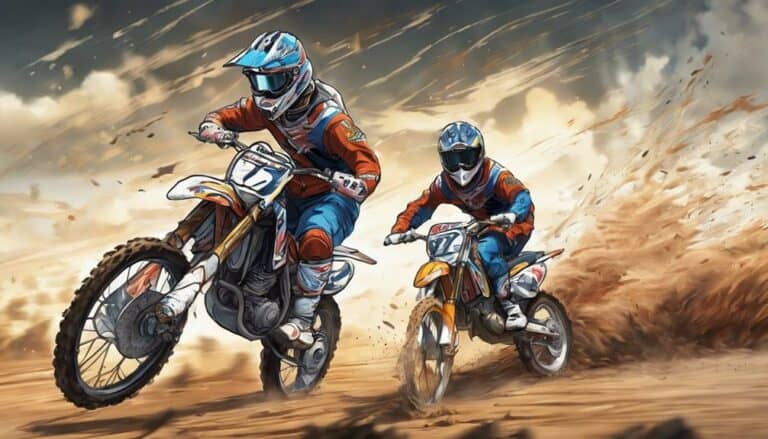When handling a dirt bike, encountering a situation where the revs increase as the handlebars turn can be as perplexing as a puzzle missing its final piece.
The unexpected revving could signal underlying issues that need attention. Understanding the root cause of this phenomenon is vital for your safety and the bike's performance.
By exploring the possible reasons for this occurrence and the necessary troubleshooting steps, you can guarantee a smoother and safer riding experience.
Stay tuned to uncover the secrets behind this intriguing dirt bike mystery.
Key Takeaways
- Cable tension and routing issues cause handlebar revving.
- Check throttle and choke cables for binding and tension.
- Professional help ensures proper cable adjustments for safety.
- Regular maintenance prevents revving problems, especially after aftermarket installations.
Understanding the Issue
When encountering the common issue of dirt bike handlebars revving up upon turning, riders often find that cable tension and routing problems are the primary culprits. The throttle on a dirt bike is directly linked to the handlebars through a series of cables. If these cables aren't properly tensioned or are routed incorrectly, it can lead to the throttle revving unexpectedly when the bars are turned. This phenomenon occurs because the cables may be pulled or stretched in a way that increases throttle input when steering.
To address this issue, riders must carefully inspect the routing of their throttle cables to make sure they aren't being pinched or pulled when the handlebars are turned to extreme positions. Adjusting the tension of the cables to the manufacturer's specifications is important in preventing unwanted revving. Additionally, any aftermarket handlebar installations should be double-checked to make sure they haven't adversely affected the cable routing or tension, which can also lead to revving problems. By meticulously examining and adjusting the cable tension and routing, riders can liberate themselves from the frustration of their dirt bike revving up unexpectedly.
Possible Causes to Consider
Consider potential causes of dirt bike handlebar revving by examining throttle and cable components for tightness and routing issues that may lead to unexpected throttle input. Insufficient free play at the throttle can result in the bike revving up when the handlebars are turned.
It's essential to check for throttle or choke cable binding caused by tightness or incorrect routing, as this could be the root of the problem. Aftermarket handlebars may impact cable tension, potentially causing the revving issue.
The throttle cable being pulled during handlebar turns is another factor that can lead to increased revving. Additionally, the choke cable stretching due to changes in handlebar position could contribute to the problem.
Troubleshooting Steps to Take
To effectively troubleshoot dirt bike handlebar revving issues, systematically inspect and test the throttle and choke cables for any binding or tension irregularities. Begin by checking for any cable catching or binding when turning the bars. Detach the choke cable housing to validate the issue between the throttle and choke cables. Relax the choke cable tension to see if the idle issue stops when disconnected. If the idle still increases, inspect and adjust the throttle cable tension. Confirm correct cable routing without sharp angles to resolve idle speed issues.
| Throttle Cables | Choke Cable |
|---|---|
| Inspect for tension | Detach from housing |
| Adjust if necessary | Relax tension if idle increases |
| Check for binding | |
| Validate proper routing |
Safety Precautions to Remember
Inspect the throttle and clutch cables with the engine off to guarantee safe troubleshooting and maintenance procedures.
Always prioritize safety precautions by turning off the engine before handling these components to avoid any sudden acceleration.
Remember to wear suitable protective gear like gloves and eye protection while working on your bike to protect yourself from potential injuries.
Avoid making abrupt adjustments to the cables without the necessary expertise to prevent damage to the system.
After any maintenance work, make sure to double-check all cable connections and routing to maintain proper functionality and safety standards.
If you're uncertain about fixing any issues related to the throttle or clutch cables, it's best to consult a qualified mechanic.
Seeking professional help can prevent safety risks and further damage to your dirt bike.
Seeking Professional Help
Seeking professional assistance for diagnosing and resolving throttle cable issues is important for ensuring top performance and safety standards on your dirt bike.
When facing revving issues or suspecting problems with cable routing, turning to a mechanic with expertise in dirt bike maintenance can provide the necessary solutions. Mechanics possess the tools and knowledge to accurately inspect cable routing, tension, and overall condition. Proper adjustment of throttle and choke cables is vital for best performance, and professionals can make sure these adjustments are made correctly.
Additionally, consulting a mechanic can help identify hidden cable issues that may not be apparent to the untrained eye. By utilizing professional help, you not only address existing problems but also prevent potential safety hazards in the future.
Conclusion
To summarize, ensuring proper cable routing and tension on your dirt bike is essential to prevent unexpected revving when turning the handlebars.
By addressing any issues promptly and following proper maintenance procedures, you can enjoy a smooth and safe riding experience.
Remember, just like a well-oiled machine, your dirt bike needs regular care and attention to function at its best.
Happy riding!

